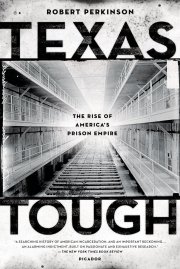
Robert Perkinson writes about the history of the Texas prison system to give tips to current reformers who want to improve the standards of the current system. The main thesis for Texas Tough is looking at the causes and consequences of the sky rocketing majority non-white prison population that started, ironically, after the Civil Rights Era of the 1960’s. Perkinson also looks at numerous causes of the bad living conditions of these prisons. He points to not only social causes like racism and peonage but also ground level causes like the relationship between the guard and the prisoner.
Some parts of this book could have been improved. For instance, the reader could tell that Perkinson has a liberal bias. The author is very harsh on conservatives and tries to get the reader to sympathize with the prisoners. For example, the author makes sure to point out that the highest number of executions in Texas took place when George W. Bush was in office. [Perkinson 37] The author has written for the liberal magazine called the Progressive. [Amazon.com author biography] He also explains that the most prevalent emotion in prison is pain that the inmates inflicted on other people but also the pain the inmate feels themselves. He then goes on to explain some of the bad childhoods that the prisoners experienced that included both physical and mental abuse. [Perkinson 23] Other people might not have focused on the inmate’s personal history and just said they must be jailed for the crime they committed. With that being said, this is not a major flaw because Perkinson also includes a large amount of evidence, statistics, and personal interviews that back up what he is asserting.s
In contrast this book does a good job of comparing the de facto racism of the past with the de jure racism of the Texas prison system today. Perkinson shows that civil rights cases like Ruiz v. Estelle have helped get rid of the worst abuses but there is a long way to go. For instance, there are more people in prisons now than in the 1960s and the vast majority of these inmates are nonwhite. This relates to the movie about the systemic racism in the housing system. It shows in both housing and prisons that individuals could have no racist ideas but the system itself is set up to hurt African-American and Latino-Americans.
Texas Tough does a good job of focusing on the landmark civil rights case Ruiz v. Estelle. The author shows how this highlighted the differences motivations people had for prisons as confinement camps or rehabilitation centers. It also showed the ambiguity of the law. For instance, the author raised the question what is the definition of “cruel and unusual punishment” or “equal justice under the law.” [Perkinson 272] Perkinson did a good job of comparing the historical impact of the case to the personal impact of the case on Ruiz. He showed it had far reaching impacts on improving prison conditions. However, it was not an absolute victory for Ruiz as he spent most of the rest of his life behind bars and ended up dying in prison. [Perkinson, 357-373] This is similar to The Arc of Justice where the Sweet court cas had major implications for improving civil rights. However, Sweet, himself, had a troubled life and ended up committing suicide.
Perkinson does a particularly good job in his closing chapter. He has a very detailed explanation of where the Texas prison system has been and also the present state of affairs. He makes an interesting observation that there is a cycle of reform, reaction, neglect, and reform again. Instead of focusing on the short-term personal stories he focuses on the organizational systems and structures that make up the “long duree.” [Perkinson 367] This is an interesting contrast to almost all of the historical markers that relate to race in the twentieth century that portray constant progress. Instead, Perkinson shows that in some ways the prison has gotten better and in others it has gotten worse. For instance, he states the prisons have become more impersonal because they are more bureaucratic. [Perksinson 361] This is similar to the way Oshinsky ended his book Worse than Slavery. Oshinsky said the present Parchman Farm had gotten rid of the worse racist abuses but the author quoted a long term prisoner who missed the old days because he felt that work gave his life meaning instead of just sitting in a cell all day. [David Oshinksy, Worse Than Slavery Parchman Farm and the Ordeal of Jim Crow Justice (New York: Free Press, 1996), 248]


